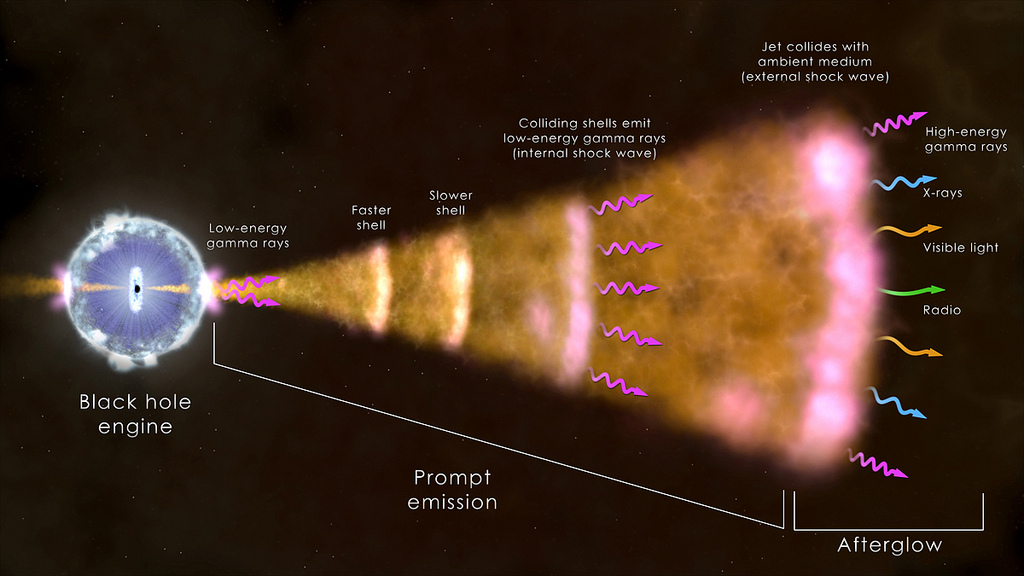Black hole birth captured by ‘armada of instruments’
November 25, 2013

An artist’s conception of the processes by which a star collapses and becomes a black hole, releasing high-energy gamma rays and X-rays, as well as visible light, in the process (credit: NASA)
“Los Alamos’ RAPTOR telescopes in New Mexico and Hawaii received a very bright cosmic birth announcement for a black hole on April 27,” said astrophysicist Tom Vestrand, lead author of a paper n the journal Science Nov. 21 that highlights the unusual event.
“This was the burst of the century,” said Los Alamos co-author James Wren. “It’s the biggest, brightest one to happen in at least 20 years, and maybe even longer than that.”
The RAPTOR (RAPid Telescopes for Optical Response) system — designed by Los Alamos National Laboratory — is a network of small robotic observatories that scan the skies for optical anomalies such as flashes emanating from a star in its death throes as it collapses and becomes a black hole, an object so dense that not even light can escape its gravity field.
This flash — optical light generated simultaneously with x-rays and gamma rays during a gamma ray burst (GRB) — provides clues about the nature of the explosions that occur as massive stars collapse. It arrived from the constellation Leo in the form of an exceptionally bright flash of visible light that accompanied a powerful burst of cosmic gamma-ray emissions. It lasted about 80 seconds before it faded below the ~10th magnitude sensitivity limit of the RAPTOR full sky monitors.
Witnessed by an armada of instruments
What made such an extremely rare event even more spectacular for scientists, however, is that, in addition to the RAPTOR sighting, it was witnessed by an armada of instruments — including gamma-ray and X-ray detectors aboard NASA’s Fermi, NuSTAR and Swift satellites. While the NASA instruments recorded some of the highest-energy gamma-ray bursts ever measured from such an event, RAPTOR noticed that the massive and violent transformation of a star into a black hole yielded a lingering “afterglow” that faded in lock-step with the highest energy gamma-rays.
“This afterglow is interesting to see,” said paper co-author Przemek Wozniak of Los Alamos’s Intelligence and Space Research Division. “We normally see a flash associated with the beginning of an event, analogous to the bright flash that you would see coinciding with the explosion of a firecracker. This afterglow may be somewhat analogous to the embers that you might be able to see lingering after your firecracker has exploded. It is the link between the optical phenomenon and the gamma-rays that we haven’t seen before, and that’s what makes this display extremely exciting.”
A Rosetta-Stone event
The event was among the brightest and most energetic of its type ever witnessed. “This was a Rosetta-Stone event that illuminates so many things — literally,” Vestrand said. “We were very fortunate to have all of the NASA and ground-based instruments seeing it at the same time. We had all the assets in place to collect a very detailed data set. These are data that astrophysicists will be looking at for a long time to come because we have a detailed record of the event as it unfolded.”
Already the event, labeled GRB 130427A by astrophysicists, is testing some long-held assumptions about the nature of the universe. For example, scientists recorded energy levels for gamma rays that are higher than what some researchers thought theoretically possible. This revelation may require physicists to modify existing theories about radiation. No doubt, the data set could yield more surprises in the future, Vestrand said.
Other organizations affiliated with the research include Stanford University, the University of Alabama, Las Cumbres Observatory Global Telescope Network and the Universities Space Research Association.
Abstract of Science paper
The optical light generated simultaneously with x-rays and gamma-rays during a gamma-ray burst (GRB) provides clues about the nature of the explosions that occur as massive stars collapse. We report on the bright optical flash and fading afterglow from powerful burst GRB 130427A. The optical and >100 MeV gamma-ray flux show a close correlation during the first 7000 s, best explained by reverse shock emission co-generated in the relativistic burst ejecta as it collides with surrounding material. At later times, optical observations show the emergence of emission generated by a forward shock traversing the circumburst environment. The link between optical afterglow and >100 MeV emission suggests that nearby early peaked afterglows will be the best candidates for studying particle acceleration at GeV/TeV energies.